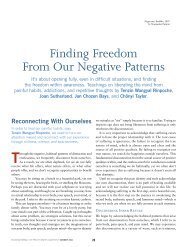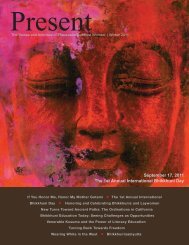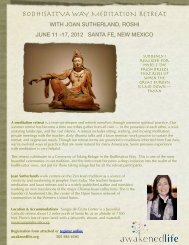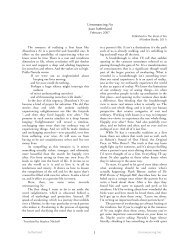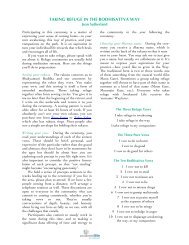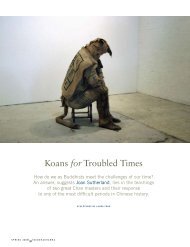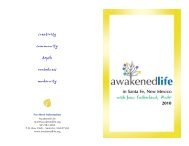Rakusu Instructions - Awakened Life
Rakusu Instructions - Awakened Life
Rakusu Instructions - Awakened Life
Create successful ePaper yourself
Turn your PDF publications into a flip-book with our unique Google optimized e-Paper software.
NOTES ON THE RAKUSU<br />
The rakusu represents the robes that Shakyamuni wore, and we wear it in memory of the Buddha’s<br />
teachings. We also remember those whose commitment and courage carried Chan/Zen through the centuries<br />
so that we can live it now : The rakusu was created during the devastating persecutions of Buddhism in<br />
China during the 9 th century CE. Monastics were forcibly returned to lay life, and some of them made<br />
rakusus, which could be easily hidden under ordinary clothes, as a miniature version of the robes they were<br />
no longer allowed to wear.<br />
Sewing a rakusu takes some time, and that's what lets our hearts and psyches in. We have to stop; we<br />
have to not do all the other things we spend our time doing, and we sit and sew. In sitting and sewing, alone<br />
and in the company of our rakusu-making friends, we begin to hear the small voices often drowned out—<br />
voices from our heart-mind and from the world around us—and that wisdom and those blessings are<br />
stitched into our rakusus as well.<br />
We make the rakusu out of lots of little pieces of fabric stitched together by hand. It's like our lives : We<br />
make a life from bits of this and that, and after awhile a pattern begins to emerge. In ancient times<br />
monastics would go to the town dump to pick up pieces of different fabric, dye them one color, and sew their<br />
robes from them. Out of many, one—and nothing rejected, nothing excluded.<br />
<strong>Rakusu</strong>s are usually made of dark colors because they’re<br />
of the dark earth from which we all come, of which we’re made,<br />
and to which one day we’ll return. There's a quilt-like pattern in<br />
the center of the rakusu which represents the rice fields that<br />
are the foundation of Asian Buddhist cultures. It connects us<br />
to all the careful cultivation of land and the Way that's gone<br />
on through the generations.<br />
The rakusu is continuous all the way around except for one<br />
place, the ring. Traditionally this was made of bone, but now<br />
it’s usually made of wood or plastic, though ceramic or other<br />
1<br />
VERSE OF THE RAKUSU<br />
This is the robe of freedom<br />
the bare field, the blessings.<br />
I receive the Tathagata’s teaching<br />
which wakes all beings.<br />
materials would work as well. This is the one place there's a gap, and resting in the gap is a circle that<br />
represents the infinite. So it's through the place that's not continuous, through the crack, that the light of<br />
the vastness emerges.<br />
You sew a green pine needle on the piece that sits at the nape of your neck. This represents the<br />
mountain and forest traditions out of which we come. It also represents all living things, long life, and, like<br />
pine needles that come in bundles, the many out of one.<br />
The first time you put on your rakusu each day, place it, still folded, on top of your head, put your palms<br />
together, and recite the Verse of the <strong>Rakusu</strong>. Thereafter, you can just touch the rakusu to your forehead<br />
and put it on. <strong>Rakusu</strong>s can be worn anywhere except into a bathroom; if you’re working you can turn the<br />
rakusu around so that the pine twig is at your throat and the rakusu hangs down your back. It’s customary<br />
to put it on your cushion rather than the floor and not to stack anything on top of it. You should be able to<br />
spot clean or dry clean your rakusu, but the writing on the underside might not survive laundering.<br />
When you’ve finished sewing your rakusu you’ll give it to your teacher, who puts it on her or his altar and<br />
lives with it for awhile before writing on the white silk that will sit next to your heart. Your dharma name is<br />
there, in the formula ‘Today So-and-so takes up the bodhisattva way’, to remind you that this is not<br />
something you do once, but every day of your life. In accepting your rakusu back from your teacher, you’re<br />
committing to this Way and this community. Welcome home.<br />
Vernal Equinox 2008



